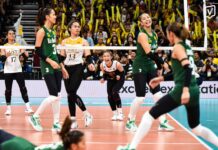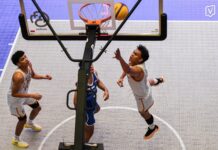TEN YEARS of high-octane dragon boat rowing.
For an international sports squad to survive this long even without the luxury of having a regular team sponsor or even a school to represent, it is correct to say that the Aqua Fortis Dragon Boat Rowing Team (AFDBRT) is truly a product of pure passion. In its 10 years of existence, this Thomasian-laden team has gone to restless bodies of water to pocket strings of medals and place the country’s name in the international dragon boat racing circuit.
And speaking of medals, the AFDBRT just secured a bronze in the 2004 Taipei International Dragon Boat Championship (TIDBC) last June 20-22, where more than 80 countries participated.
Notwithstanding their success, only a handful from the Thomasian community know the sport exists. Even worse, only a few are aware of the AFDBRT’s existence.
“It’s sad to say that the sport is only known to few, that’s where the lack of support starts,” senior team official Christopher Cueto told the Varsitarian.
‘Strong water’
It took an Architecture student to come up with the idea of establishing a Thomasian rowing crew back in 1991. Jovel Versoza, a member of the Philippine Dragon Boat Rowing team, founded the UST Rowing Team, whose lineup was composed mainly of Architecture, Fine Arts, and Engineering students. The squad then trained and sought action in local races, and went against different universities and private companies in national tournaments. Racking up experience points in every race, Versoza’s wards then were elevated to international ranking, carrying the country’s colors, while clashing against the rowers from Hong Kong, Macau and Taipei, and ended up with noteworthy finishes.
Just a year after, more rowing aspirants joined the team’s cause. Thus, the AFDRT was formed in June 1994. Aqua Fortis (from Latin, meaning “strong water”) was the phrase that the team lived by. Even then, the team was not recognized by the University.
“The Amateur Rowing Association of the Philippines did not allow us to carry the name of UST because we are not recognized by the school, so we were obliged to change our name,” Cueto, a Graduate School student, said.
Also in 1994, the team geared up for a stint at the Chueng Cheng Cup in Taiwan, where they finished second and fifth in the men’s category and mixed category.
The succeding years saw the addition of more members and even more female rowers. In his final year as captain, Versoza made a graceful exit by spearheading the team to a stellar campaign in 1995 TIDBC, where they bagged a silver medal.
Then, the torch was passed to Cueto in 1996. For a decade now, the AFDBRT displayed classic performances at the TIDBC, which simply contradicted the notion of their underdog status.
“You can see in [our] history that we have a lot of strong finishes despite our underdog standing,” Cueto further explained.
The veteran rower also said his team is constantly in search for sponsors and government support.
“Some companies provide us uniforms and equipment, and some aid us financially. At least we only pay half of our airfare. But the pathetic thing is that we’re representing the country, yet we get little support from the government,” Cueto explained. “In the end, it’s still our own money that we spend in international events”.
Without a permanent backer, the AFDBRT is still trying to establish a name in water sports to attract willing sponsors.
All business
“Right now, we’re in the recruitment process,” Cueto said. “Our main focus is on international races, particularly the Thailand Swan Boat Championships in September.”
The team trains every Sunday at the Manila Bay, and desperately continues to expand the dragon boat racing scene in the country.
Cueto added the AFDRT is a more stable sports organization compared to other university teams because most of its members stay even after graduation.
“Most people come and go in other organizations. But here, when members graduate, they stay closer to the team now that they earn money for races,” Cueto said.
Passion has been their primary paddle in maneuvering against the notorious water rapids and their determination has been keeping them on the surface for the kill. They may not carry the black, gold, and white colors of UST in their quests, nor wave the University’s flag, but one thing’s for sure—they were conceived in España, and continue to make Thomasians proud.

















